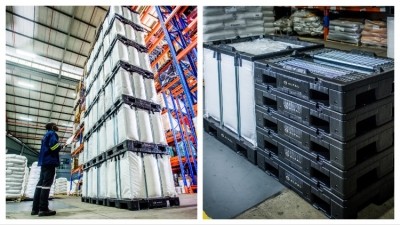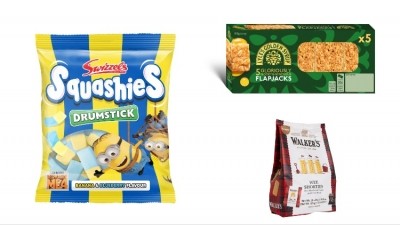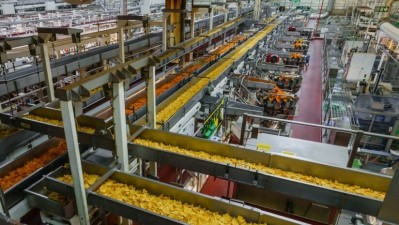Feature
Can F&B arrest the investment decline?

The Food and Drink Federation’s (FDF) most recent state of the industry report painted a concerning picture for food and drink investment.
Published every quarter, the most recent iteration from May 2024 showed that investment levels into the F&B sector declined by 30.5% between 2019 and 2023. This contrasted with the wider UK manufacturing sector picture, where investment actually rose by 5.4%.
The indictors for Q1 of this year suggest “it will take time before [the F&B sector] returns to pre-pandemic levels”, with few food and drink manufacturers feeling able to invest.
Why is investment in food and drink manufacturing on the decline?
Almost half of the report’s respondents flagged concerns around business environment changes as a hinderance. According to those surveyed, this has been reducing the net return of some projects.
Demand uncertainty was also highlighted as a root cause, with 43% citing this as an inhibitor; while others pointed to the cost of finance, regulatory uncertainty and labour shortages.
In response to the findings, Balwinder Dhoot, director of sustainability and growth at the FDF, said that the food and drink sector had been hit particularly hard by rising costs “from energy and agricultural commodities, to labour, transportation and packaging”.
He added that a decline in consumer purchasing power amidst the cost-of-living crisis has also led to reduced household spend on food and drink.
“To combat these substantial cost pressures, businesses have postponed or cancelled investment projects and diverted those funds to day-to-day operations. They have also reduced marketing and training budgets and have switched suppliers,” he continued.
Commenting on the dramatic fall in investment over the past five years, F&B industry analyst and corporate finance director at solicitors firm Rollits, Julian Wild, said that, in large, food manufactures are simply insecure.
“They are not sufficiently confident of the future of their business and, particularly their customer base, to be confident to invest. [Meanwhile], with interest rate rises the cost of borrowing has increased significantly,” Wild explained.
Meanwhile, the founder and CEO of gluten-free oat producer Glebe Farm Foods, Philip Rayner, noted that higher taxes on asset purchases have also been proving an impediment.
“Additionally, the risks associated with business expansion and the financial burdens from credit requests by retailers further discourage investment,” Rayner told Food Manufacture.
Both also pointed to the impact of Brexit, with Wild contending that the UK’s departure has led to wage inflation and labour shortages.
“Employees are much harder to find post-Brexit and with increasing immigration controls,” Wild said. “The UK needs overseas workers who are willing to work in the relatively unattractive food manufacturing conditions. These jobs will not all be filled by UK workers.”
Growth of the food and drink sector has been slow compared to other industries in recent years, and Shaun Browne, a managing director and co-head of corporate finance for Europe at investment banking firm Houlihan Lokey, believes this is limiting its appeal to external investors.
Browne named factors such as stable overall consumption, intense retail competition driving down prices and consumer preference shifting towards lower-cost private label products as some of the major drivers.
“Investing in F&B manufacturing is comparably less attractive than other sectors in the current environment, which has led to the shortage of capital flowing into the industry,” he said.
“Investors have a diverse range of options for investment across different industries. They are economically rational and will invest where they are likely going to generate the highest returns for the least risk. As there is a finite pool of capital available, projects in the F&B sector must compete with other industries to attract investment by demonstrating competitive returns relative to risk.”
Why is investment so important?
With firms of all sizes facing a series of economic challenges over the past five years, it is understandable that investment levels have fallen. However, as Browne told Food Manufacture, ongoing investment is necessary for all businesses if they want to remain financially competitive.
“If a competitor upgrades to a faster and more efficient production line, they can serve customers better and at a lower cost,” he said.
“Companies that fail to invest risk losing market share and eventually the prospect of closure.”
This assessment is backed up by the figures with food and drink firm administrations doubling during 2023, according to research by insights firm Kroll. Beyond maintaining market share though, Browne said that investment in health and safety initiatives and hygiene controls is also crucial in the F&B sector.
“It is essential for maintaining consumer trust and regulatory compliance,” he added.
Meanwhile, Dhoot noted that only through investment would food and drink manufacturers be able to support the “prosperity” of their local communities.
“[We need to] create well-paid and higher-skilled jobs to help raise living standards and ensure that everyone, everywhere, everyday has access to affordable, nutritious food,” he explained.
Bucking the wider industry trend, Glebe Farm Foods has managed to invest in a new Tetra Pak packing line and facility in the past few years, while also improving the circular use of its oat by-products to produce energy.
“[Investment is] needed to ensure that we don’t just keep up to date with the market, but actually challenge and get ahead with NPD, R&D as well as production efficiency,” Rayner pointed out.
“There are opportunities for cost savings and carbon reduction by using renewable energy for electricity and heat. While the payback period can be long, genuine sustainability efforts are increasingly important. Over the past decade, Glebe Farm Foods has innovated by using oat chaff for renewable steam generation and installing rooftop solar to cut electricity demand. We plan to add another 900kW of solar power to reach net zero by 2028.”
Wild told Food Manufacture that sizable investment in the sector during the 1980s led to the “convenience food revolution” and a period of growth.
“As in any sector, investment is fundamental to businesses growing, innovating, taking on more employees, acquiring new property, plants and machinery, as well as making suitable acquisitions,” Wild explained.
“Without it, businesses stagnate and start to decline.”
Browne agreed, adding that fresh funds are necessary to reduce the industry's “over-reliance” on manual labour.
“In a period where labour markets are increasingly competitive and wages are rising, investing in automation and technology can reduce dependency on manual processes, which can become challenging to hire for and manage effectively in the long term,” Browne elaborated.
This was also echoed by Dhoot: “Food and drink manufacturers need to invest to address systematic challenges facing the sector, from strengthening the UK’s food security and building more resilient supply chains, to creating a sustainable food system and improving poor diets by developing healthier products. Investing in innovation is the fundamental driver of long-term growth, as it improves productivity and competitiveness.”
How can the sector encourage and attract fresh investment?
It would be fair to say that the sector needs a new approach to drive investment.
Browne believes that in order to appeal to outside investors, food and drink firms need to demonstrate that they can put the money to good use and enhance their profitability.
“This involves increasing sales volumes or reducing manufacturing costs while maintaining pricing levels,” he explained.
“Enhancing market competitiveness through innovation in product development, operational efficiency, and meeting consumer demand for quality and sustainability is crucial.”
If firms are unable to deliver on this, Browne expects investors will continue to look at other sectors: “Investors maintain a rational approach and expect F&B companies to demonstrate that financial investments can effectively boost future profitability.”
Meanwhile, Wild hopes to see more partnerships forming between manufacturers and retailers with the long-term interests of the sector at their core.
“We saw [more collaboration] in the 1980s when companies like M&S committed to long-term supply arrangements with their major food suppliers, who then had the confidence to invest,” Wild recalled.
“Ever since tendering and online auctions emerged, manufacturers have no confidence in retaining business when everything is driven by price.”
This was reiterated by Rayner: “Customers co-investing and collaborating with suppliers, whether by direct investment or by good credit terms to reduce risk, or just being there to help share the risk on new products, will help support growth and opportunity.”
Wild also believes that the F&B industry should look to reduce its reliance on private equity investment. He argued that such firms are driven by “how much debt they can put into transactions and very short-term turnarounds” rather than the long-term interests of the business and sector.
“We need to see the emergence of more food and drink companies with a long-term commitment to the sector and major customers in retail and food service willing to support their supply base to create a real partnership for growth,” he added.
Under the new Labour Government, Wild believes progress is possible but that it will be slow and hard earned: “It is to be hoped that a different mindset of collaboration, sustained support for business and a more long-term outlook can change the whole environment and encourage good companies to invest and grow. Otherwise, we face a real risk of food shortages.”
Dhoot added that the FDF was ready to work alongside the new UK Government to create a “stable regulatory framework” which would allow the F&B sector to better compete in a difficult funding landscape.
“The UK is renowned for food science, R&D and innovation, with global manufacturers choosing the UK for R&D and SMEs creating market-disrupting products. But investment is highly competitive with global food and drink manufacturers competing within their businesses for investment in new production lines, products and packaging across the markets in which they operate,” Dhoot said.
“We welcome the Government’s vision for an industrial strategy. We hope this will drive good regulation and a dynamic business environment, alongside effective cross-government and intra-sector engagement. There are huge opportunities here to seize, to ensure our industry – an advanced manufacturing sector – drives economic growth and skills development up and down the country.”
What’s next?
As Wild and Dhoot noted, the election of a new government has the potential to bring about change, and Rayner hopes to see actions that will help firms struggling with high costs and stagnant productivity.
“If [Labour] can stabilise these costs and ideally re-join the common market, it could significantly improve the situation for UK businesses by reducing export friction,” the oat milk innovator said.
Dhoot added that if the Government can create the right incentives and work with industry, the F&B industry “could see a sustained rise in business investment”.
“With business conditions stabilising, there is the opportunity for food and drink manufacturing investment to bounce back,” he continued.
“Although, economic conditions remain tough and margins have been squeezed, there is increased optimism in the industry, with around 90% of businesses aiming to sustain or increase their investment in R&D and plant and machinery. Geopolitics and adverse climate events continue to pose risks to manufacturers’ operations which might impact investment decisions.”
Browne has also witnessed cost inflation squeeze the profit margins of F&B companies: “This was exacerbated by a delay in passing on these higher costs to retailers and consumers, significantly impacting profitability from mid-2022 to mid-2023. As we all know, food and beverage prices increased sharply during this period causing a spike in overall inflation figures.”
While inflation had a huge impact on consumers, Browne said it allowed manufacturers to “rebuild their profit margins, thus positioning themselves to become more attractive investment propositions in the future”.
“As investors begin to observe improved financial results from these companies, their prospects for attracting investment are on the rise,” he concluded.
Glebe Farm Foods is certainly committed to continued investment and is now installing a bulk UHT Pallecon line.
Rayner added: “Despite these difficulties, Glebe Farm Foods continues to be bold and committed to innovation and expanding on its long line of 100% gluten-free produce. We are also developing applications for sustainable bakery, rusks and nutrition with customers for our core gluten-free oat flakes, flour and granola ingredients.”
We can surely expect ups and downs, and new, unexpected obstacles in the next five years, but all the signs indicate that positive change could be afoot in the world of F&B investment.
In other news, McCain Foods GB has issued an immediate recall notice for nine non-compliant products.
















